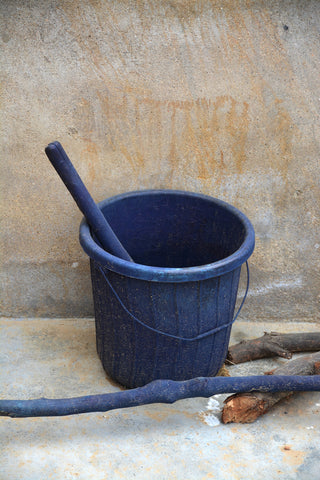Dabu block printing is a treasured craft meticulously preserved and passed down through generations in the quaint town of Bagru, Rajasthan. As an eco-conscious e-commerce business, Metaphor Racha is committed to supporting and documenting this rich tradition, aiming to shed light on its profound impact on the world of textiles.
A Glimpse into the Dabu Process
Dabu, a resist-printing technique, involves covering portions of the cloth with clay or wax to protect these areas from the dye. This unique process allows for the creation of intricate patterns and vibrant backgrounds. The beauty of Dabu lies in its ability to produce delicate and striking designs, a true reflection of the artisan's skill and creativity.
The Various Faces of Dabu
The process of Dabu printing is as diverse as it is complex. The technique can vary significantly depending on the region and the artisan's preference. Some of the popular methods include:
1. Kalidar Dabu: This method uses kali mitti (clay) soaked overnight and mixed with chunna (calcium hydroxide) to prevent cracking, beedan (moth-eaten wheat flour), and gond (Gum Arabica) to improve adhesiveness. The mixture is then strained to remove impurities, ensuring a smooth application.
2. Dolidar Dabu: This is similar to Kalidar Dabu, but with Multani Mitti (fuller earth clay) replacing the clay, offering a slightly different texture and finish.
3. Gawarwali Dabu: This method incorporates ground guar bean powder with chunna and gond, resulting in a distinctive resist-printing technique.
4. Mein ki Dabu: A wax-based resist print offering a unique approach to the traditional Dabu methods.

Crafting the Fabric
The Dabu paste is carefully applied to the fabric using wooden blocks. After the application, sawdust is sprinkled onto the fabric and left to dry. This step ensures the paste acts as a binder, preventing the dye from penetrating the covered areas during the dyeing process. The fabric is then immersed in a cold dye solution, with indigo being a popular choice for its rich and deep hues.


The Indigo Dyeing Ritual
The printed fabric, folded neatly like sari pleats, is gently submerged into the indigo tank. The dyer carefully opens each pleat while holding the fabric underwater, ensuring an even dye application. This meticulous process helps prevent the cracking of the Dabu resist. As the fabric emerges from the tank, it reacts with the atmospheric oxygen, transforming the reduced indigo into its iconic oxidized blue. The fabric is re-dipped and oxidized multiple times to achieve a darker shade. Once the desired hue is reached, the fabric is laid flat to dry, with utmost care taken to maintain the integrity of the Dabu resist.


A Palette of Natural Colors
While indigo is a staple in Dabu printing, other natural dyes also play a significant role. Haldi (turmeric) offers a bright yellow hue, Manjishta (madder) provides a soft red, and Nashpal (pomegranate rind) imparts a greenish-yellow shade. At Metaphor Racha, we have adapted the traditional Dabu process by treating the fabric with harda before dyeing. This creates a unique dark green colour, adding a modern twist to a timeless craft.

A Modern Touch to a Traditional Craft
While we honour the traditional methods of indigo dyeing, we have embraced German indigo. This adaptation preserves the essence of Dabu printing and aligns with our commitment to sustainability and innovation.
In the words of a revered artisan, "Craftsmanship is not just a skill; it's a legacy." At Metaphor Racha, we are dedicated to preserving this legacy, supporting local artisans, and sharing the beauty of Dabu block printing with the world. Join us in celebrating this extraordinary craft, a testament to the enduring spirit of Indian artistry.

1 comment
Like to know about ur method about dabu print. My work is similar with this but I m doing hand dyeing n block printing of discharge print ..some of experiment gives similar results even not use this technic…